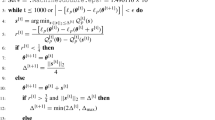Abstract
As is well known, when using an information criterion to select the number of common factors in factor models the appropriate penalty is generally indetermine in the sense that it can be scaled by an arbitrary constant, c say, without affecting consistency. In an influential paper, Hallin and Liška (J Am Stat Assoc 102:603–617, 2007) proposes a data-driven procedure for selecting the appropriate value of c. However, by removing one source of indeterminacy, the new procedure simultaneously creates several new ones, which make for rather complicated implementation, a problem that has been largely overlooked in the literature. By providing an extensive analysis using both simulated and real data, the current paper fills this gap.



Similar content being viewed by others
Notes
See Pesaran (2006) for an alternative approach based on the cross-section averages of the observed data.
In their illustrative examples, Hallin and Liška (2007) use ocular inspection of graphs similar to Fig. 1 identify the second stability interval. But they do not describe in detail how the approach is operationalized in their Monte Carlo study. We experimented with a large number of alternative search schemes, but found that the one based on setting \(\hat{c}\) according to the second interval for which \(S_c^2 = 0\) tended to perform best. In this paper, we therefore only consider this scheme, which is the same as the one employed by Alessi et al. (2010).
This is in agreement with the results of Bai and Ng (2002) showing how \(IC_{p1}\) tend to underestimate \(r_0\) when N and/or T are “small”.
The data are available at http://www.princeton.edu/~mwatson/wp.html.
References
Ahn SC, Horenstein AR (2013) Eigenvalue Ratio test for the number of factors. Econometrica 81:1203–1227
Alessi L, Barigozzi M, Capasso M (2010) Improved penalization for determining the number of factors in approximate factor models. Stat Probab Lett 80:1806–1813
Amengual D, Watson M (2007) Consistent estimation of the number of dynamic factors in a large \(N\) and \(T\) panel. J Bus Econ Stat 25:91–96
Bai J (2003) Inferential Theory for factor models of large dimensions. Econometrica 71:135–171
Bai J, Ng S (2002) Determining the Number of factors in approximate factor models. Econometrica 70:191–221
Baltagi BH, Kao C, Na S (2013) Testing for cross-sectional dependence in a panel factor model using the wild bootstrap \(F\) test. Stat Pap 54:1067–1094
Bernanke B (2004) The great moderation. Remarks at the Eastern Economic Association Meetings, Washington
Breitung J, Eickmeier S (2011) Testing for structural breaks in dynamic factor models. J Econom 163:71–84
Breitung J, Pigorsch U (2013) A canonical correlation approach for selecting the number of dynamic factors. Oxf Bull Econom Stat 75:23–36
Hallin M, Liška R (2007) Determining the number of factors in the general dynamic factor model. J Am Stat Assoc 102:603–617
Kosfeld R, Lauridsen J (2008) Factor analysis regression. Stat Pap 49:653–667
Ng S, Perron P (1995) Unit root tests in ARMA models with data dependent methods for selection of the truncation lag. J Am Stat Assoc 90:268–281
Onatski A (2009) Testing hypotheses about the number of factors in large factor models. Econometrica 77:1447–1479
Onatski A (2010) Determining the Number of factors from empirical distribution of eigenvalues. Rev Econom Stat 92:1004–1016
Pesaran MH (2006) Estimation and inference in large heterogeneous panels with a multifactor error structure. Econometrica 74:967–1012
Stock JH, Watson MW (2005). Implications of dynamic factor models for VAR analysis. NBER Working Paper No. 11467
Stock JH, Watson MW (2008) Forecasting in Dynamic factor models subject to structural instability. In: Castle J, Shephard N (eds) The Methodology and practice of econometrics, a festschrift in honour of professor David F. Oxford University Press, Oxford
Acknowledgments
The authors would like to thank Simon Svensson, Christine Müller (Editor) and two anonymous referees for their very constructive comments. Financial support from the Knut and Alice Wallenberg Foundation and the Jan Wallander and Tom Hedelius Foundation is gratefully acknowledged.
Author information
Authors and Affiliations
Corresponding author
Rights and permissions
About this article
Cite this article
Westerlund, J., Mishra, S. On the determination of the number of factors using information criteria with data-driven penalty. Stat Papers 58, 161–184 (2017). https://doi.org/10.1007/s00362-015-0692-0
Received:
Revised:
Published:
Issue Date:
DOI: https://doi.org/10.1007/s00362-015-0692-0




